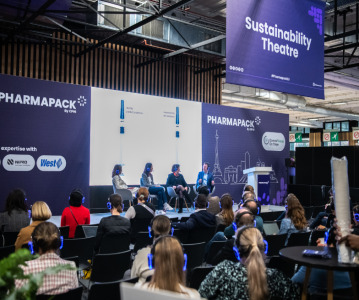To recruit or to retain - where is the pharma talent going?
.png)
Discover how the pharmaceutical workforce has evolved past the pandemic, and the challenges faced by the pharma industry during a talent acquisition and retention crisis.
While speaking of pharmaceutical manufacturing, development, and commercialisation trends may showcase the innovation on which the industry prides itself, there remains one element that affects every step of the pharmaceutical supply and value chain to take into increased consideration. Talent acquisition has been a growing worry for many in the pharmaceutical sector since the on-set of the COVID-19 pandemic; 3 years later, recruiting managers are still at a standstill when it comes to finding the right workforce for their pharmaceutical companies or clients.
Though strategic recruitment is not a challenge that is unique to the pharmaceutical industry, there are several important factors weighing upon an industry that saw unprecedented levels of market growth and innovation since the start of the COVID-19 pandemic [i]. With niche roles going unfilled and changing priorities within the industry itself, pharmaceutical recruiters and talent managers are consistently searching for ways to stay ahead of the talent crisis curve and attract the workforce they need. In parallel, the tech industry has seen mass layoffs after a surge in hiring and growth during the pandemic years, while also suffering from a shortage of necessary talent in key areas – since the start of 2022, the tech industry has seen over 78,000 individuals made redundant [ii]. As the global biotechnology market is estimated to reach USD $1683 billion by 2030, how can these two industries converge [iii]?
In this feature article, we examine how the pharma workforce has evolved through several challenges in the last 5 years, from reshoring and nearshoring efforts to pandemic-induced supply chain disruptions. We’ll also investigate the type of talent pharma is most interested in recruiting, and how those struggling to find work in adjacent industries may find their skills are in need by pharmaceutical giants.
Changing priorities, not people
For the pharmaceutical industry, the number of roles and occupations across the life sciences and healthcare industries are expected to grow 7% by 2028 according to the US Bureau of Labor Statistics [iv]. With such growth, pharma recruiting is expected to be an area where companies can either flounder or thrive, says Neil Kelly, Founder of Vector Partners and Talent Sandbox. “There’s definitely less hiring happening at the moment, particularly in outsourcing spaces of CROs, CDMOs etc. This is being driven predominantly by the speed at which new molecules are going to market although this is on the back of 2022 that I have never experienced in my career – investment is slowing down in a lot of these biologics businesses, so within the supply chain there’s been a knock-on effect to those who they outsource,” he explains. Combined with a lack of skilled workers with the niche talents required by innovative biotechs and drug developers, increasing wages, and soaring costs of materials and services, it is unsurprising that there has been a marked shift in how pharma recruiters prioritise their existing and potential workforce [v]. Saying that, what has been interesting is the shift in buying habits, those CDMOs, who offer innovative more niche offerings, have seen an uptick in their business.
Additionally, with reshoring and nearshoring efforts on the rise, particularly within the US, pharmaceutical manufacturers are having to intensify their discussions and efforts in recruiting the right workforce or face potential pipeline delays and overall performance decline in US-based CDMOs [vi]. For companies with inadequately trained employees boasting only rudimentary knowledge and skills in GMP manufacturing, quality control, and project management, such nearshoring and reshoring efforts might do more detriment to the pharmaceutical supply chain than provide political benefit [vi].
An important factor to remind biotech companies, outsourced pharma partners, and relevant companies is that retention forms the other part of the recruitment equation. Employee burnout and increased turnover in the pharmaceutical industry presents a unique challenge to an industry looking for highly specialised individuals to operate and thrive in a corporate setting with a patient-centric approach [iv].
Developing a sustainable workforce
A mere 40% of pharmaceutical companies believe they know and understand where gaps exist in their skill force, and operational disruptions such as new therapeutic modalities like cell and gene therapies have created a skill mismatch in over 80% of pharmaceutical manufacturing companies [vii]. It is quickly becoming apparent that simply reacting to market changes and the dwindling pool of the necessary talent is not enough for those in manufacturing and the pharmaceutical supply chain to keep up and stand out as a leading partner [viii]. One strategy for pharmaceutical recruiters, notably those involved in the outsourcing sector, to keep in mind is investing in the talent pool that already exists in their current workforce.
Kelly states that despite the reduction in external hiring, “there is an increase, across the board, with internal mobility, which some larger organisations call their talent marketplace - hiring from their existing talent. So, while there is a reduction in external hiring, companies are saying ‘okay how can we get more from our existing internal workforce more efficiently.’ We’re also seeing this in CDMO businesses, whereby they are looking internally at who is performing and how they are performing, through to how can talent be upskilled or reskilled to create more productivity internally.” By setting out to determine the gaps in their skill force and strategizing a training plan that works within the companies business goals, pharmaceutical companies can better position themselves to create and maintain a sustainable workforce.
Fears of technology and automation stealing individual jobs are not unfounded (according to a McKinsey report, 50% of existing work activities in the pharmaceutical and healthcare sectors could be automated, with 90,000 jobs set to disappear in 10 years [vii]), but there still remain opportunities for companies who shift their mindset with such technological shifts – while new tech may replace manual and physical labour, the demand for technological skills, patient-centric approaches and thought leadership is growing [vii]. In particular, demand for those skilled in data analysis, data science, and data engineering are four times higher than the current supply [vii], an unsurprising challenge for an industry becoming increasingly data-driven and generating large amounts of clinical, preclinical, and commercial data, especially real-world evidence [ii]. Hamish Vadher, a mid-market Account Executive at hackajob, states that those with the right technical skills may see a potential future in pharma, especially if they have prior experience. “Having knowledge of [fast-moving consumer goods and] those types of industries is also really important: usually, those within pharma typically want people to have experience within fast-moving consumer goods as well as those industries as regulated as pharma,” he explains. “Experience in a particular, regulated industry is really helpful, but if you’re a python developer in another company, there’s still merit in having a conversation with [the pharma sector].”
Yet, a survey of pharmaceutical manufacturers and companies revealed that only a third have effectively launched reskilling efforts [vii]. So in addition to reskilling, what else can be done, or is currently being done, to meet operational demands? Can this tech talent be found elsewhere, perhaps outside the pharmaceutical industry?
Big Tech to Big Pharma: taking the leap?
Across the industry talent pool in tech, talent acquisition and retention seem to be facing an equally challenging landscape. Vadher comments that the tech talent industry is “very volatile in the sense that there’s lots of movement – whether that’s employees looking to move to new businesses, or whether companies are actively headhunting and taking from competitors using tech stacks or similar disciplines. It’s a very tough industry and a competitive market right now. A lot of organisations are struggling to find good tech talent and propel their businesses into profitable points.” To highlight the disparity between tech’s demand for talent and the current pool of candidates, Vadher gives an estimate of two positions available for every technician or engineer with the right set of skills and candidate expectations. Yet, the years following the COVID-19 pandemic have seen an exceptional number of layoffs for tech companies, which Vadher links to rising inflation after a booming year in 2020 for e-commerce, digital trading, and online events.
“[Tech] organisations ramped up very, very fast post-COVID, and are now downsizing very fast as well. We don’t see that as much in pharma,” Kelly states. “In pharma, it’s a very different supply chain and sale cycle. We’re talking 10-year investment cycles on products and molecules, so the dynamic is very different. I also believe that Big Pharma have a better grip on how they manage their workforce. They think about things in a very long-term view.” Kelly emphasises that the reason the pharma industry is able to do so, in comparison to the tech industry, is due to the long lifecycles for products that take years to get to market, and that the healthcare industry will only continue to expand. “You’ve got an increase in the middle class across the world, you’ve got greater income in emerging countries, so healthcare will expand. Pharma companies currently make a high level of profit on the products they sell, although with greater access to drugs, then this might change. I think that’s the key factor here – although the tech sector does make good profit, [the pharmaceutical industry] maintains a sustainable profit over a long period of time. The reality is that people’s health will come first, ahead of a piece of technology.”
Experts still remain cautious about relying on a surge of skilled workers from the tech industry to flood the pharma landscape, however. In a survey conducted by hackajob, tech talent were likely to be attracted to an organisation based on salary, with nearly a third of participants stating that remuneration played an important role in attracting them to a particular organisation [ix]. “It’s benefitting pharma in such a way that because pharma has deeper pockets, they are able to offer a higher salary to obtain the type of talent they require (data analysts, data engineers etc.),” Vadher states. This, along with pharma’s trend towards sustainable business growth and a very real hunger for those skilled in handling large amounts of data, could potentially make the pharmaceutical industry an attractive transition for those leaving tech.
However, Kelly caveats that “within any industry, you’re always going to have niche roles that are difficult to hire. For CDMOs and CROs, there are certain roles around the acquisition of people e.g. clinical management of trials. The same story in the CDMO world with particular engineering, quality, or scientific skills that are required.” For all the potential that the pharma industry may have for skilled individuals looking to jump from tech, Kelly states that there will always remain some difficulty in finding the perfect candidate for certain roles, especially as many employers define the profile poorly: “For roles that are technology-based, such as those programming the technology used to manufacture and produce drugs, those were not skills that really existed less than 10 years ago. The challenge is the speed of developing curriculum in higher education is not keeping pace with the rapid development of skills in Pharma 4.0, which we now see how this is impacting hiring. The point is, whether you’re in the pharma sector or the tech sector, when you’re trying to hire roles that have a heavy influence of innovations in areas that are now mature with poor talent supply chains, then it is always going to be difficult to hire them.”
So where does that leave us? Two industries with limited talent pools, scrambling to reskill their existing workers and nowhere to go?
Kelly is not so pessimistic: “The influence of the tech sector will continue and I am very excited about how Pharma companies augment their effectiveness with technology. What’s interesting is that the tech industry is having a stronger appetite for the healthcare sector.” He cites an effort made by Amazon to move into the distribution of healthcare products with a specific division in Amazon, as does Microsoft. “They know it’s so lucrative, they know there’s such a big market out there. Fundamentally, I think the skills between a technology business and a manufacturing business are very different. I think what we’re going to start to see is a lot more collaboration between these businesses to get these products to market faster. You’ll also see a competition of market space rather than talent space, short-term. Over a 25-year career, I’ve seen it before: you’ll see the brain drain from tech to pharma and other industries cycle. No doubt with any large addressable market like Pharma, you will see an increase in competitiveness and appetite to gain a slice. These companies will move from tech to pharma and then tech will pull them back in 18 months’ time. That’s where I think the partnerships will become that much more critical in the future. Bringing in the right blend of businesses and industries together to push towards a faster output for the patient, which is ultimately what we’re trying to do. We only need to look at the recent pandemic, companies recognise doing the right thing beyond profits is becoming more important for a sustainable future.”
A week after we spoke, Syneos and Microsoft announced a multi-year collaboration to leverage OpenAI technology and data solutions to accelerate clinical trials through to commercial programs for biopharma customers [x].
References
[i] Top 5 Trends Pharma Recruiters Need to Know in 2023 [Accessed April 3 2023] https://starcircle.com/top-5trends-pharma-recruiters-need-to-know/
[ii] Laid off by Big Tech? Big Pharma wants you [Accessed April 3 2023] https://www.fastcompany.com/90788218/tech-layoffs-big-pharma-hiring
[iii] Biotechnology Market – Global Industry Analysis [Accessed April 3 2023] https://www.precedenceresearch.com/biotechnology-market#:~:text=The%20global%20biotechnology%20market%20was,8.7%25%20from%202023%20to%202030.&text=North%20America%20has%20accounted%2037.76%25%20revenue%20share%20in%202022.
[iv] Recruiting and Retaining Talent is the Biggest Challenge Facing the Pharmaceutical Industry [Accessed April 4 2023] https://www.pharmexec.com/view/recruiting-and-retaining-talent-is-the-biggest-challenge-facing-the-pharmaceutical-industry
[v] CPHI Report Presents Shifting Outsourcing Realities [Accessed April 4 2023] https://www.outsourcedpharma.com/doc/cphi-report-presents-shifting-outsourcing-realities-0001?vm_tId=2508200&vm_nId=79593&user=89865bd3-f28b-4761-af3e-b631b60e909a&gdpr=1&vm_alias=CPHI%20Report%20Presents%20Shifting%20Outsourcing%20Realities&utm_source=mkt_OUTPH&utm_medium=email&utm_campaign=OUTPH_03-15-2023&utm_term=89865bd3-f28b-4761-af3e-b631b60e909a&utm_content=CPHI%20Report%20Presents%20Shifting%20Outsourcing%20Realities&mkt_tok=MDc1LU5WQy0wODYAAAGKhHOltk6BRCaJJYlW7cx1tOpMqyB2o27Zu-XGsynITxBOOyhz3kUmmzN-xufnrdHM6Ah4cKs8ZjHd2OlGGkCt2aBdYK341bLHaan3VCq_4EHu
[vi] CDMO Performance, The Workforce, And Reshoring [Accessed April 4 2023] https://www.outsourcedpharma.com/doc/cdmo-performance-the-workforce-and-reshoring-0001
[vii] Pharma operations: Creating the workforce of the future [Accessed April 5 2023] https://www.mckinsey.com/industries/life-sciences/our-insights/pharma-operations-creating-the-workforce-of-the-future
[viii] Talent Transformation in Pharma: Getting Ahead of Change in Pharma Manufacturing [Accessed April 4 2023] https://beamery.com/resources/talent-attraction-acquisition/talent-transformation-in-pharma-getting-ahead-of-change-in-pharma-manufacturing
[ix] What do Tech Talent want in 2023? [White paper] https://hackajob.com/b/employer/report/what-do-tech-talent-want-in-2023
[x] Syneos Health Collaborates with Microsoft to Accelerate AI Across the Clinical to Commercial Continuum [Accessed April 6 2023] https://www.globenewswire.com/news-release/2023/03/20/2630079/0/en/Syneos-Health-Collaborates-with-Microsoft-to-Accelerate-AI-Across-the-Clinical-to-Commercial-Continuum.html#AI
Related News
-
News US FDA adds haemodialysis bloodlines to devices shortage list
On March 14, 2025, the US FDA published an open letter to healthcare providers citing continuing supply disruptions of haemodialysis bloodlines, an essential component of dialysis machines. -
News Women in Pharma: Manufacturing personal and team success
Our monthly Women in Pharma series highlights the influential lives and works of impactful women working across the pharmaceutical industry, and how the industry can work towards making the healthcare industry and workplace more equitable and inclusive... -
News Pfizer may shift production back to US under Trump pharma tariffs
At the 45th TD Cowen annual healthcare conference in Boston, USA, Pfizer CEO Albert Bourla outlined the potential for Pfizer to shift its overseas drug manufacturing back to the US as pharmaceutical industry players weigh their options against Presiden... -
News Experimental drug for managing aortic valve stenosis shows promise
The new small molecule drug ataciguat is garnering attention for its potential to manage aortic valve stenosis, which may prevent the need for surgery and significantly improve patient experience. -
News Women in Pharma: Connecting accessible pharma packaging to patients – a Pharmapack Special
Throughout our Women in Pharma series, we aim to highlight how CPHI events encourage discussions around diversity, equity, and inclusion initiatives in the pharmaceutical industry. -
News Vertex Pharmaceuticals stock jumps as FDA approves non-opioid painkiller
UK-based Vertex Pharmaceuticals saw their stock shares soar as the US FDA signed off on the non-opioid painkiller Journavx, also known as suzetrigine, for patients with moderate to severe acute pain, caused by surgery, accidents, or injuries. -
News Trump administration halts global supply of HIV, malaria, tuberculosis drugs
In various memos circulated to the United States Agency for International Development (USAID), the Trump administration has demanded contractors and partners to immediately stop work in supplying lifesaving drugs for HIV, malaria, and tuberculosis to c... -
News 2024 Drug Approvals: a lexicon of notable drugs and clinical trials
50 drugs received FDA approval in 2024. The centre for biologics evaluation and research also identified six new Orphan drug approvals as under Biologics License Applications (BLAs). The following list picks out key approvals from the list, and highlig...
Recently Visited
Position your company at the heart of the global Pharma industry with a CPHI Online membership
-
Your products and solutions visible to thousands of visitors within the largest Pharma marketplace
-
Generate high-quality, engaged leads for your business, all year round
-
Promote your business as the industry’s thought-leader by hosting your reports, brochures and videos within your profile
-
Your company’s profile boosted at all participating CPHI events
-
An easy-to-use platform with a detailed dashboard showing your leads and performance







